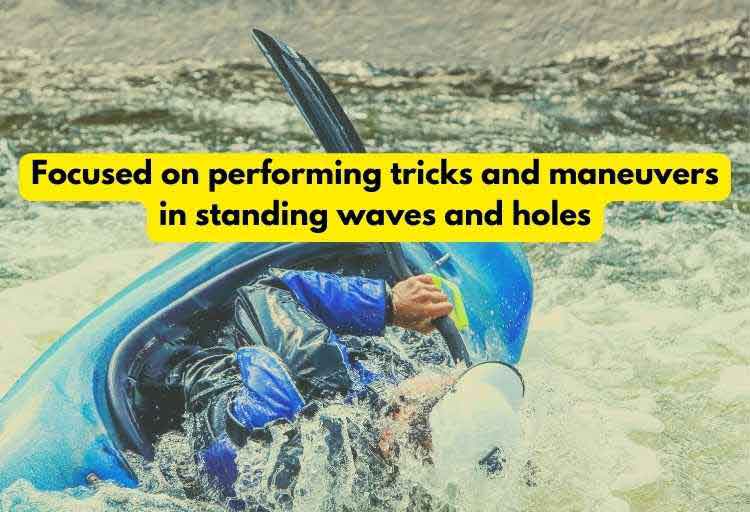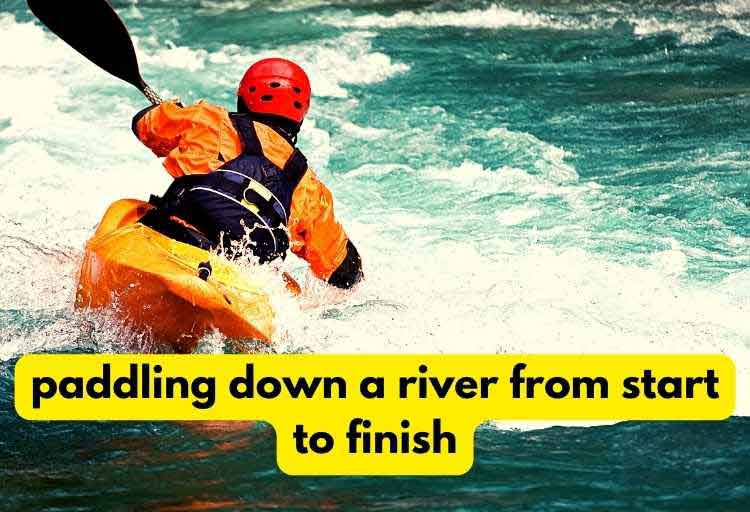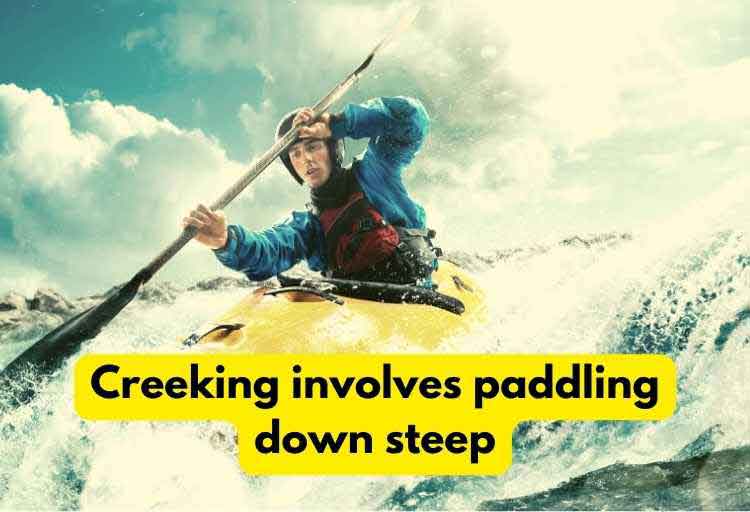Do you crave adventure and a rush of adrenaline? But stuck at whether whitewater kayaking is dangerous or not? Then the answer might surprise you! In short, whitewater kayaking is not inherently dangerous. Moreover, this thrilling whitewater kayaking has gained popularity among enthusiasts seeking an exciting challenge. But it can be dangerous if you don’t know proper kayaking techniques for whitewater.
Yet, it brings a nagging question: what might be the potential dangers? And whether or not whitewater kayaking is suitable for their skill levels.
In this article, we’ll be discussing the various aspects of whitewater kayaking, including the risks involved and the safety measures you can take to ensure a safe and enjoyable experience. We’ll also be debunking some common myths surrounding the sport and exploring the allure that draws so many to this thrilling activity.
I started whitewater kayaking as a beginner and was initially intimidated by the sport. However, with proper training and guidance from experienced kayakers, I quickly gained confidence and have since had many successful and enjoyable experiences on the water. It’s important to start with easier rapids and work your way up as you gain more experience and skill.
So, let’s dive into the world of whitewater kayaking and explore the question on everyone’s mind: is it too dangerous to try?
Jump To A Section
How dangerous whitewater kayaking is for beginners?
Whitewater kayaking can be a challenging and potentially dangerous sport, especially for beginners who lack experience and proper training. It’s an extreme sport that involves navigating through fast-moving and turbulent waters, which can be intimidating to many people.
The level of danger involved in whitewater kayaking depends on several factors, including the difficulty of the river, the weather conditions, the paddler’s experience level, and the equipment used.
To be frank, it might be a bit risky if it’s your first day on the water! For beginners, we suggest you start on easy rivers or rapids and gradually work their way up to more challenging waters as they gain experience and confidence. Starting on Class I or Class II rivers, which have small waves and few obstructions, is recommended for beginners. Experienced paddlers, on the other hand, may opt for Class III, IV, or even V rapids, which are much more challenging and require a high level of skill and experience.
When you’re just starting out, it is essential to start with easy rapids and to have proper training from an experienced instructor. Whitewater kayaking requires technical skills such as reading the river, executing different types of strokes, and learning how to roll the kayak if it capsizes. Without proper training, a beginner may be at risk of injury or even drowning.
Knowing how to navigate through rapids and learning proper paddling techniques can help paddlers stay safe. Also, keep an eye out for river features, such as strainers and hydraulic jumps.
These factors may seem even more daunting. But with the proper precautions, anyone can minimize these risks and enjoy the thrill of whitewater kayaking safely.
A Brief To Whitewater Kayaking And Its Types
Whitewater kayaking involves paddling a specialized kayak down a river or a stretch of whitewater. The goal of the sport is to navigate through the rapids, waves, and other obstacles that are found in the river using a combination of skill, strength, and strategy.
Whitewater kayaks are typically shorter and wider than a traditional touring kayaks. And these are designed for high maneuverability in fast-flowing water. In a double-bladed paddle, the paddler propels themselves down the river from a cockpit sealed with a spray skirt.
Kayaking on the whitewater is an exciting and challenging activity that requires a great deal of skill and experience. It is also a highly physical activity that can provide a great workout for those who participate.
Different types of whitewater
There are several different types of whitewater, each with its own unique characteristics and challenges. The International Scale of River Difficulty is used to classify rivers based on their difficulty level, ranging from Class I (easy) to Class VI (extremely difficult and dangerous).
The different types of whitewater include:

Playboating: This type of kayaking is focused on performing tricks and maneuvers in standing waves and holes. Playboating is often done in a single location with artificial features, such as a whitewater park.

River running: River running involves paddling down a river from start to finish, navigating through rapids and obstacles along the way. River running can be done on a variety of rivers, ranging from easy Class I rivers to more challenging Class V rivers.

Creeking: Creeking involves paddling down steep, narrow, and technical rivers that are often characterized by waterfalls and tight drops. Creeking is considered one of the most challenging forms of whitewater kayaking and requires advanced skills and experience.
Expedition kayaking: Expedition kayaking involves multi-day trips down remote and often unexplored rivers. This type of kayaking requires extensive planning and preparation, as well as advanced skills and experience.
Understanding the different types of whitewater can help paddlers choose the right river and level of difficulty for their skill level and experience.
Potential Dangers Of Whitewater Kayaking
With any high-intensity activity comes a certain level of risk, and many people wonder if whitewater kayaking is truly safe. And it’s essential to understand these risks before getting started, as this will help you mitigate them.
The main risks associated with whitewater kayaking include the following:
Drowning: The most significant risk associated with whitewater kayaking is drowning. The fast-moving water, rocks, and other obstacles in the river can create hazardous conditions that can lead to accidents and injury.
Hypothermia: Whitewater kayaking typically takes place in cold water, which can quickly lead to hypothermia if the paddler falls into the water or becomes wet. Hypothermia can be life-threatening if not treated promptly.
Injuries: The fast-moving water and rocks in the river can lead to injuries such as cuts, bruises, broken bones, and head injuries.
Equipment failure: Equipment failure can also be a risk factor in whitewater kayaking. If the kayak, paddle, or other gear fails, it can lead to accidents and injury.
Environmental hazards: Whitewater kayaking can also expose paddlers to environmental hazards such as strong currents, waves, and rapids that can be difficult to navigate.
For such potential dangers, it’s best to take a whitewater kayaking course. And learn the necessary skills and techniques to stay safe on the water!
Statistics on Whitewater Kayaking Accidents
Whitewater kayaking is an exciting and challenging sport, but it’s not without its risks.
On January 14th, 2023, an incident occurred at Big Splat Rapid on the Big Sandy in West Virginia. The Lower Big Sandy was planned without a shuttle partner by Zack, Blake, and Nathan. They were hoping to catch a ride with local paddlers. But it was a cloudy day with temperatures in the 20s! So most locals took the day off. Although the group was an expert boater who had run the Green River Narrows, there were a few rapids on this river that were difficult, and one particularly dangerous Big Splat.
There were several factors that contributed to this incident. First, the group did not have a shuttle arranged, which led them to attempt the run without local support. Second, the weather conditions were not favorable, with a cloudy day and temperatures in the 20s. Third, although the paddlers were experienced on other rivers, they were not familiar with Lower Big Sandy. It includes some tricky rapids, including Big Splat, which has killed one person and seriously injured several others.
Common causes of whitewater kayaking accidents
Lack of skill: One of the most common causes of accidents in any outdoor activity is lack of skill. Whitewater kayaking requires a certain level of proficiency in order to navigate the rapids safely. Inexperienced paddlers are more likely to capsize, get pinned on rocks or strainers, or suffer other accidents.
Shuttle arrangements
Another common cause of accidents is poor planning and lack of proper shuttle arrangements. If you don’t have a shuttle partner, you might attempt to run difficult rapids without transport to your vehicle. In cold weather, this can lead to dangerous situations.
Unfamiliarity with the spot
Whitewater kayaking requires knowledge of the river and its features. If a paddler is unfamiliar with a particular rapid or stretch of river, they may not be aware of hidden obstacles or hazards that can pose a danger. It’s important for paddlers to scout rapids and become familiar with the river before attempting to run them.
Lack of scouting
Scouting is the process of visually inspecting a rapid or stretch of river from shore before attempting to navigate it. Paddlers who do not take the time to properly scout a rapid may not be aware of hazards like undercut rocks, strainers, or other obstacles. This can lead to accidents and injuries.
Compared to other outdoor activities, whitewater kayaking has similar risks to whitewater rafting, canoeing, and swimming. In contrast to hiking and camping, water is unpredictable and moves fast, which increases the risks.
The key to staying safe on the water is to wear appropriate safety gear, make sure the equipment is in good working order, and get proper training. By taking these steps, paddlers can minimize the risks associated with this thrilling sport and enjoy it safely.
The 3 Myths About White Waters
Are you someone who has always been fascinated by the idea of kayaking through the roaring rapids of a white water river but has been too intimidated to give it a try? It’s time to debunk the myths that have been holding you back!
Whitewater kayaking is mysterious. And many assume it’s just for the most adventurous and skilled kayakers.
In reality, there are many levels of difficulty and accessibility for whitewater kayaking, and safety measures are in place to ensure an enjoyable experience for all.
So let’s dive into the three most common myths about white waters and why they’re just not true.
Myth 1: Whitewater Kayaking is Only for Experts
One of the most common myths about whitewater kayaking is that it is only for experts. Many people assume that this activity is only for those who have years of experience and have reached an advanced level of proficiency in kayaking. People often assume whitewater kayaking requires a high level of skill because it is potentially dangerous.
In reality, there are different levels of difficulty in whitewater kayaking. The International Scale of River Difficulty categorizes rapids into six classes, ranging from Class I (easy) to Class VI (extremely dangerous and almost impossible to navigate). Beginners can start with Class I or Class II rapids, which are relatively easy and have few obstacles, such as rocks or drops. As they gain more experience, they can progress to more challenging rapids.
Accessibility of whitewater for different skill levels
Whitewater kayaking is accessible for people of different skill levels as long as they are willing to learn and follow safety guidelines. Kayaking schools and guides offer lessons and tours specifically designed for beginners, which include instruction on basic paddling techniques, safety procedures, and appropriate gear. With proper training and guidance, even beginners can safely navigate Class I and Class II rapids.
Myth 2: Whitewater kayaking is too dangerous
Another common myth about whitewater kayaking is that it is too dangerous. While it is true that there are potential risks with this activity, many people tend to overestimate the danger involved.
Whitewater kayaking can be dangerous if proper safety measures are not taken. Some of the risks associated with this activity include capsizing, hypothermia, and drowning. However, with the appropriate gear, training, and preparation, many of these risks can be minimized or avoided altogether. Wearing a properly fitting personal flotation device (PFD), helmet, and appropriate clothing can help prevent injury and hypothermia. Additionally, kayakers should be aware of weather conditions, river levels, and potential hazards on the river and should always paddle with a partner or group.
Myth 3: Too expensive and requires expensive equipment
Some people assume that whitewater kayaking is too expensive and requires expensive equipment. They may assume that only those with large disposable incomes can afford to participate in this activity.
While it is true that some equipment can be expensive, such as a high-end kayak or specialized gear, there are many affordable options available for those on a budget. For example, beginners can rent equipment from kayak schools or outfitters for a reasonable price. Additionally, buying used equipment or looking for sales can significantly reduce the cost of kayaking gear. As for the activity itself, there are many public river access points that offer free or low-cost parking and put-in/take-out areas.
Alternative options for those on a budget
For those on a budget, there are also alternative options for experiencing whitewater kayaking, such as kayaking on flat water or slower-moving rivers. These options can provide a similar kayaking experience without the added risk and expense associated with whitewater kayaking. Additionally, many kayaking schools and outfitters offer group discounts or package deals that can make the activity more affordable for those on a budget.
The 3 Easy Whitewater Kayaking Spots For Beginners
There are a lot of spots for a whitewater kayaking enthusiast. But not all of them are easy for beginners. That’s why I’ve included some as an addition!
Here are three easy whitewater kayaking spots with lower rapids that are suitable for beginners:
Lower New River, West Virginia – With Class I-III rapids, this is a great spot for beginners to learn and improve their kayaking skills.
Nantahala River, North Carolina – This river is popular for its gentle rapids (Class II-III) and scenic beauty, making it a popular spot for families and beginners.
The Green River, North Carolina: It is a popular destination for kayakers of all levels of experience to explore the Green River. It offers a range of rapids, from Class II to Class V, and is known for its stunning scenery.
Even these easy spots still need proper training and preparation. And we recommend you go with experienced kayakers or groups and wear the right gear.
Importance of proper training and preparation
Proper training and preparation are crucial for whitewater kayaking. This is because whitewater kayaking is a high-risk activity that requires a certain level of skill, knowledge, and physical fitness. Without proper training and preparation, individuals may put themselves and others in danger. Here are some reasons why proper training and preparation are essential for whitewater kayaking:
“Safety” as the key
Proper training and preparation can help prevent accidents and injuries while kayaking. By learning how to paddle correctly, reading water, and understanding river dynamics, kayakers can make better decisions on the water, avoiding dangerous obstacles and currents.
Physical Fitness
Whitewater kayaking requires a certain level of physical fitness. Proper training can help individuals improve their strength, endurance, and flexibility, which will help them handle the physical demands of the sport.
Confidence
Proper training and preparation can help kayakers feel more confident on the water. Confidence can help kayakers make better decisions and react more quickly to changing river conditions, which can help them avoid accidents and injuries.
Skill Development
Proper training can help kayakers develop the skills they need to navigate challenging whitewater. This includes learning how to execute different paddle strokes, perform rolls and braces, and read the water.
Respect for the River
Whitewater kayaking is not just a physical activity; it also requires an understanding and respect for the natural environment. Proper training can help individuals develop an appreciation for the river, its power, and its beauty and learn how to minimize their impact on the environment.
Final words
As you venture into the exciting world of whitewater kayaking, it’s crucial to prioritize safety above all else. Don’t let the thrill of the sport overshadow the importance of proper preparation and precautions. Always wear appropriate safety gear, scout the rapids before paddling through them, and never attempt anything beyond your skill level.
Remember, accidents can happen even to the most experienced paddlers, and the consequences can be severe. By prioritizing safety, you protect not only yourself but also those around you. So, whether you’re a beginner or an expert, make sure to take every necessary precaution and prioritize safety on the river.


